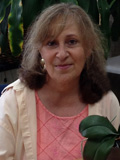|

Tracy Iftikar
|
|

Andrea Poulos
|
|

Parthy
Schachter
|
In fall of 2015, the three of us sat in a classroom with three
other colleagues in the ESL Program at the University of
Wisconsin-Madison. Two of the other attendees were graduate students
teaching in our program and the other was one of our administrative
staff members. It was the first official meeting of our Reading Group on
Race and ESOL Teaching. Before the discussion of the reading Tracy had
chosen for this first meeting, Kubota and Lin’s (2009) chapter titled
“Race, Culture and Identities in Second Language Education: Introduction
to Research and Practice,” we each stated what had brought us to the
group. As the founder of the reading group, Tracy’s interest in this
project was related to her identity as a person of color, interest in
exploring issues of race and language education, and desire to explore
ideas with colleagues rather than just struggling with readings on her
own. Andrea chose to participate because she had been thinking about
race for a long time, has been involved with various diversity projects
over the years, and felt this would be an important ongoing discussion.
Parthy’s interest was due in particular to discussions on race in her
social media circles. Though our backgrounds and individual reasons for
coming to the group varied, a common theme was that race matters in our
teaching and that we hoped that this reading group could be a way to
address the gap in professional development regarding race at our
institution. There was also an underlying urgency to explore race as the
national dialogue about race continues to impact the lives of our
students.
Prior to this first meeting, Tracy formally proposed the idea
to the director of the ESL program, sent an email to all staff members
in the program about the group, and conducted a Doodle poll to find the
best time. Since the first meeting, our reading group has met three or
four times a semester for 90-minute sessions. Discussions are based
largely on theoretical articles with themes related to critical
pedagogy, critical race theory, racial inequality and ESOL teaching.
Though we value personal experiences and they have naturally become part
of our discussions, we use the ideas in the articles to ground our
discussion, and we find that the “distance” achieved by using the
“academic” articles can actually lead to a more focused and open
conversation. The reading group continues to be open to all staff in our
ESL program, not just instructors. We have not used any type of formal
reading list; rather, Tracy chooses articles by looking at introductory
texts and referenced sources, examining notes on discussion points and
questions to be further explored from meetings, and taking broader
recommendations from her husband, who is a graduate student studying
race.
Our progression as a group has been organic in many ways. None
of us is an expert in the area of race, and we continue to develop a
shared language. For example, recurring ideas in our readings such as racism as normal and othering
often do not immediately make sense. Together we are learning how racism
can operate unseen and often unquestioned. We are learning how speaking
English is often associated with being white, and how our ESOL students
can be marked and treated as different. With time, as we see how the
ideas are discussed in different readings, we start to make connections
between the readings, and to our roles as language educators. Some of
our readings are also not specific to language education, and we have to
figure out the connections on our own. For example, as we have read
articles about whiteness in education or about the seemingly broad
definition of culture, we have worked together to see points of
application in ESOL. At times we struggle with certain ideas or terms,
and we use popular resources such as Google, newspaper clips, and
magazine articles to support our understanding. We also jot down notes
for further follow-up. While there are certainly moments of confusion
and frustration and we often end with more questions than answers, the
ongoing nature of the group allows us to return to topics again and
again.
On occasion, it has been challenging to not have an expert to
elaborate on and clarify ideas for us, or to guide our discussions. For
example, we realize that without deeper knowledge of a specific concept
such as Pierre Bourdieu’s habitus or Robert
Phillipson’s linguistic imperialism, our
understanding of an article could be limited, and that we cannot
realistically explore every idea referenced in an article. On the other
hand, it has been helpful and motivating to chart our own reading course
as we try to parse out what areas to focus on. We are invested in what
we discuss, and our choice for the reading for the next meeting is often
inspired by questions from the previous meetings. Sometimes we use
discussion questions provided with some of the articles. Most of the
time, after a quick review of the last meeting and opportunity for
anyone to clarify or follow up on previous points of discussion, Tracy
starts our discussions with broader questions such as, “What did you
think of this article?” and “What were some questions you had?”
Conversations about race can feel fraught; there seem to be so
many ways to get it wrong. For example, Motha (2014) challenges us to
recognize that the teaching of English has not been a “race-neutral,
apolitical, ahistorical endeavor” (p. 2). As we learn about the tension
that she explains as “the contradiction” of English, where the spread of
English has been empowering at the same time that it has been
oppressive, it can be difficult to critically examine our roles within
this contradiction. In addition, we have had different reactions to and
interpretations of complex topics such as white
supremacy, racism and privilege. We continue to provide each other the
space to freely share, question and learn ideas. Reading and talking
about race in response to other scholars and thinkers has allowed us to
not only broaden our perspectives and deepen our discussions, but also
to think beyond the often assumed practice vs. theory dichotomy. We view
theory as important, accessible and relevant to all staff members.
Sometimes there is discomfort with focusing on abstract ideas without
more concrete examples. Other times, when we do read about or discuss
concrete examples, it is unsettling because it seems to imply that there
is a formula or correct way to teach or be critical. In the end, we
realize that theory and practice are intertwined.
Interestingly, this reflection on the role of race in ESOL has
happened not only in the structured meetings, but in multiple other
informal ways such as conversations via email or in hallways and offices
as colleagues share thoughts with us about the readings or topics.
Email invitations to meetings always emphasize that previous knowledge
and prior attendance are not required, and the readings are always sent
to every staff member in our program at least one week before the
meeting. While the three of us have become the core members of the group
and attendance has varied from just us three to six or seven
participants, we have created a space for a continuous dialogue on race
in our program. In fact, some colleagues print out and skim the articles
even if they cannot attend, and one staff member has shared multiple
recommendations for books and campus talks related to race.
Especially in this political climate where racism has
increasingly played such an “acceptable” role in policies and
conversations regarding immigrants and people of color, we have found
that a reading group can be helpful in maintaining an ongoing
conversation about race that is collaborative and meaningful. We hope
that by sharing some of our experiences, along with the challenges and
our responses, you can see how you might start such a group in your
specific context. DiAngelo and Sensoy (2010) state that critical
practice “requires a deep and sophisticated analysis, self-awareness,
inter-group experience, and on-going education” (p. 102). We continue to
meet as a group to review what different thinkers say, and we can hold
those ideas up in the prism of others’ thinking as well. The prism is
turned one way and then another, not only in our official group meeting,
but as we find each other in the staircase in passing and in slowed
walks from teaching in other buildings. Sometimes the talk is
theoretical, sometimes it is awash in the latest news, and sometimes it
is cleaved to the classroom or a particular learner. We are grateful for
the expanding conversation as we continue our roles as learners of race
and language education and as ESOL practitioners.
References
DiAngelo, R., & Sensoy, Ö. (2010). “OK, I get it! Now
tell me how to do it!”: Why we can’t just tell you how to do critical
multicultural education. Multicultural Perspectives,
12(2), 97-102.
Kubota, R., & Lin, A. (2009). Race, culture and
identities in second language education: Introduction to research and
practice. In R. Kubota & A. Lin (Eds.), Race, culture,
and identities in second language education: Exploring critically
engaged practice (pp. 1-23). New York, NY:
Routledge.
Motha, S. (2014). Race, empire, and English language
teaching: Creating responsible and ethical anti-racist
practice. New York, NY: Teachers College Press.
Reading List
This working list
includes texts explored in our reading group on race and ESOL teaching
at the University of Wisconsin-Madison ESL Program since fall of
2015.
Introductory Readings Kubota, R., &
Lin, A. (Eds.). (2009). Race, culture, and identities in second
language education: Exploring critically engaged practice.
New York, NY: Routledge.
Markus, H.R., &
Moya, P.M.L. (Eds.). (2010). Doing race: 21 essays for the
21st century. New York, NY: W.W. Norton
& Company
McCoy, D. L., &
Rodricks, D. J. (2015). Critical Race Theory in higher education: 20
years of theoretical and research innovations. ASHE Higher
Education Report, 41(3), 1–117.
https://doi.org/10.1002/aehe.20021
Motha, S. (2014). Race, empire, and English language teaching: Creating
responsible and ethical anti-racist practice. New York, NY:
Teachers College Press.
Additional Readings Alexander, M. (2010). The new Jim Crow: Mass incarceration in the age of
colorblindness. New York: New Press.
Bonilla-Silva, E.
(2015). More than prejudice: Restatement, reflections, and new
directions in critical race theory. Sociology of Race and
Ethnicity, 1(1), 73–87.
DiAngelo, R. J. (2006).
The production of whiteness in education: Asian international students
in a college classroom. Teachers College Record, 108(10), 1983–2000.
DiAngelo, R., &
Sensoy, Ö. (2010). “OK, I get it! Now tell me how to do it!”: Why we
can’t just tell you how to do critical multicultural education. Multicultural Perspectives, 12(2), 97-102.
Gorski, P. (2016).
Rethinking the role of ‘culture’ in educational equity: From cultural
competence to equity literacy. Multicultural Perspectives,
18(4), 221-226. doi: 10.1080/15210960.2016.1228344
Haque, E., &
Morgan, B. (2009). Un/Marked Pedagogies: A dialogue on race in EFL and
ESL settings. In R. Kubota & A. Lin (Eds.), Race,
culture, and identities in second language education: Exploring
critically engaged practice (pp. 271-285). New York, NY:
Routledge.
Johnston, B. (1999).
Putting critical pedagogy in its place: A personal account. TESOL Quarterly, 33(3), 557–565.
https://doi.org/10.2307/3587680
Lee, E. (2015). Doing
culture, doing race: Everyday discourses of ‘culture’ and ‘cultural
difference’ in the English as a second language classroom. Journal of Multilingual and Multicultural Development, 36(1),
80-93.
Leonardo, Z. (2004).
The color of supremacy: Beyond the discourse of ‘white privilege’. Educational Philosophy and Theory, 36(2), 137–152.
Leonardo, Z. (2004).
Critical social theory and transformative knowledge: The functions of
criticism in quality education. Educational
Researcher, 33(6), 11–18.
Leonardo, Z. (2009).
The myth of white ignorance. In M. Apple (Ed.), Race,
whiteness, and education (pp.107-125). New York, NY:
Routledge
Liggett, T. (2014). The
mapping of a framework: Critical race theory and TESOL. Urban
Review, 46(1), 112-124.
doi:10.1007/s11256-013-0254-5 Luke, A. (2009). Race
and language as capital in school: A sociological template for language
education reform. In R. Kubota & A. Lin (Eds.), Race,
culture, and identities in second language education: Exploring
critically engaged practice (pp. 286-308). New York, NY:
Routledge.
Weiner, E. J. (2002).
Beyond remediation: Ideological literacies of learning in developmental
classrooms. Journal of Adolescent & Adult
Literacy, 46(2), 150–168.
Tracy Iftikar teaches in the ESL Program at
UW-Madison. She has been teaching ESOL since 1998 and previously taught
in California, Massachusetts and Japan.
Andrea Poulos has been involved in teaching and
administration in ESOL for over twenty years, including at the
UW-Madison ESL Program since 2008, and prior to that in Minneapolis, MN
and Buenos Aires, Argentina.
Parthy
Schachter has taught in Israel, Minneapolis, Chicago, and Madison at
public, private, and non-profit institutions. She currently teaches ESL
academic writing at UW-Madison. |

